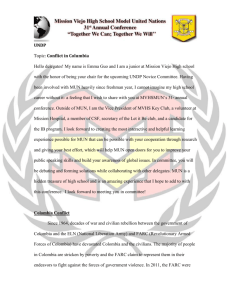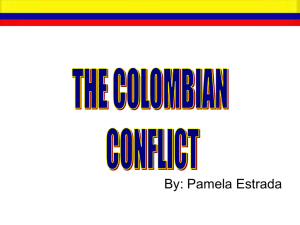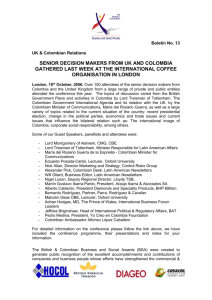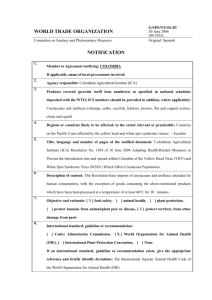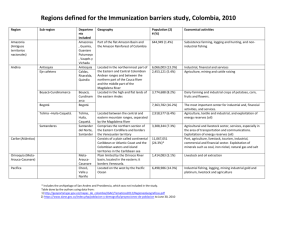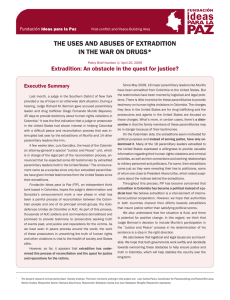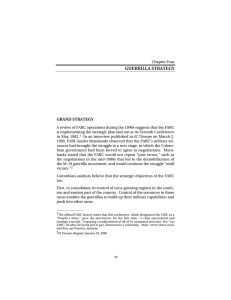H
advertisement
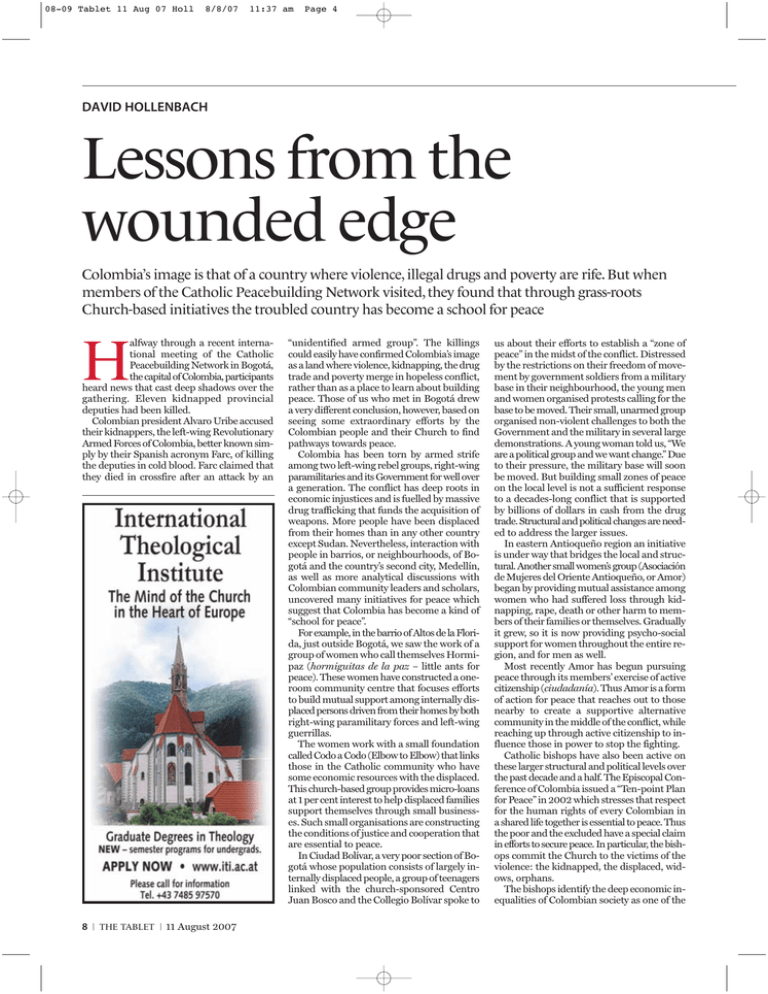
08-09 Tablet 11 Aug 07 Holl 8/8/07 11:37 am Page 4 DAVID HOLLENBACH Lessons from the wounded edge Colombia’s image is that of a country where violence, illegal drugs and poverty are rife. But when members of the Catholic Peacebuilding Network visited, they found that through grass-roots Church-based initiatives the troubled country has become a school for peace H alfway through a recent international meeting of the Catholic Peacebuilding Network in Bogotá, the capital of Colombia, participants heard news that cast deep shadows over the gathering. Eleven kidnapped provincial deputies had been killed. Colombian president Alvaro Uribe accused their kidnappers, the left-wing Revolutionary Armed Forces of Colombia, better known simply by their Spanish acronym Farc, of killing the deputies in cold blood. Farc claimed that they died in crossfire after an attack by an 8 | THE TABLET | 11 August 2007 “unidentified armed group”. The killings could easily have confirmed Colombia’s image as a land where violence, kidnapping, the drug trade and poverty merge in hopeless conflict, rather than as a place to learn about building peace. Those of us who met in Bogotá drew a very different conclusion, however, based on seeing some extraordinary efforts by the Colombian people and their Church to find pathways towards peace. Colombia has been torn by armed strife among two left-wing rebel groups, right-wing paramilitaries and its Government for well over a generation. The conflict has deep roots in economic injustices and is fuelled by massive drug trafficking that funds the acquisition of weapons. More people have been displaced from their homes than in any other country except Sudan. Nevertheless, interaction with people in barrios, or neighbourhoods, of Bogotá and the country’s second city, Medellín, as well as more analytical discussions with Colombian community leaders and scholars, uncovered many initiatives for peace which suggest that Colombia has become a kind of “school for peace”. For example, in the barrio of Altos de la Florida, just outside Bogotá, we saw the work of a group of women who call themselves Hormipaz (hormiguitas de la paz – little ants for peace). These women have constructed a oneroom community centre that focuses efforts to build mutual support among internally displaced persons driven from their homes by both right-wing paramilitary forces and left-wing guerrillas. The women work with a small foundation called Codo a Codo (Elbow to Elbow) that links those in the Catholic community who have some economic resources with the displaced. This church-based group provides micro-loans at 1 per cent interest to help displaced families support themselves through small businesses. Such small organisations are constructing the conditions of justice and cooperation that are essential to peace. In Ciudad Bolívar, a very poor section of Bogotá whose population consists of largely internally displaced people, a group of teenagers linked with the church-sponsored Centro Juan Bosco and the Collegio Bolívar spoke to us about their efforts to establish a “zone of peace” in the midst of the conflict. Distressed by the restrictions on their freedom of movement by government soldiers from a military base in their neighbourhood, the young men and women organised protests calling for the base to be moved. Their small, unarmed group organised non-violent challenges to both the Government and the military in several large demonstrations. A young woman told us, “We are a political group and we want change.” Due to their pressure, the military base will soon be moved. But building small zones of peace on the local level is not a sufficient response to a decades-long conflict that is supported by billions of dollars in cash from the drug trade. Structural and political changes are needed to address the larger issues. In eastern Antioqueño region an initiative is under way that bridges the local and structural. Another small women’s group (Asociación de Mujeres del Oriente Antioqueño, or Amor) began by providing mutual assistance among women who had suffered loss through kidnapping, rape, death or other harm to members of their families or themselves. Gradually it grew, so it is now providing psycho-social support for women throughout the entire region, and for men as well. Most recently Amor has begun pursuing peace through its members’ exercise of active citizenship (ciudadanía). Thus Amor is a form of action for peace that reaches out to those nearby to create a supportive alternative community in the middle of the conflict, while reaching up through active citizenship to influence those in power to stop the fighting. Catholic bishops have also been active on these larger structural and political levels over the past decade and a half. The Episcopal Conference of Colombia issued a “Ten-point Plan for Peace” in 2002 which stresses that respect for the human rights of every Colombian in a shared life together is essential to peace. Thus the poor and the excluded have a special claim in efforts to secure peace. In particular, the bishops commit the Church to the victims of the violence: the kidnapped, the displaced, widows, orphans. The bishops identify the deep economic inequalities of Colombian society as one of the 08-09 Tablet 11 Aug 07 Holl 8/8/07 11:37 am chief historical roots of the conflict, and call for sustainable development that will benefit all. They condemn the lack of respect for humanitarian law that should protect innocent civilians from conflict-related murder, kidnapping and displacement. They denounce corruption, the drug trade, the use of violence, as a form of terror and racial discrimination against Afro-Colombians as “social sins”, offences against human dignity that impede the pursuit of peace. In addition, bishops have established the National Conciliation Commission, which seeks peace through dialogue with both guerrillas of the Left and paramilitaries of the Right. This commission is independent of the bishops’ conference. Members of the bishops’ own Peace Commission are actively involved in discussions with Farc, others carry on negotiations with the ELN (in English, the National Liberation Army), and still others are working for the demobilisation of the paramilitary forces. This demobilisation is regrettably far from complete, and paramilitary terror is still a reality. In addition, President Uribe recently released a number of Farc guerrillas, including the movement’s “Foreign Minister” Rodrigo Granda, as part of an effort to secure a reciprocal prisoner release by Farc. Granda was granted shelter at the headquarters of the bishops’ conference in Bogotá before he travelled to Cuba for security purposes. The bishops remain strongly critical of Farc, the ELN, the paramilitaries and of notable aspects of government policy, but these criticisms do not prevent them from participating in dialogue when it promises to bring an opening to peace. Page 5 When one asks a Colombian to explain some aspect of the conflict, the response often begins with the words, “It’s complex …”. Sad to say, the Government of Colombia, with American and European assistance, has tried to reduce this complexity by heavily emphasising the military dimension and dealing with it primarily by military force. President Uribe pledged to bring the conflict to an end with an iron fist (mano dura). The United States has been supporting this approach with high levels of military assistance accompanied by chemical defoliation of coca and poppy crops. Since the Colombian conflict has many forms and multiple agents, efforts to bring peace must take many forms and be the work of multiple agents. This suggests that the US Congress is now on the right track in seeking to redirect American policy in Colombia to one that gives more emphasis to economic and humanitarian responses to the conflict and less to a heavily military response. The Church in Colombia does its peace-building work through groups ranging from displaced campesinos to the leaders of local women’s organisations and credit groups, to the leadership of guerrilla and paramilitary groups, to the Colombian Government and other governments and international organisations. These initiatives address diverse aspects of the conflict, so they hold promise of contributing essential components for a durable peace. As debates about peacemaking in regions from Colombia to Iraq go forward, all of us can learn from the multi-dimensional and multilevelled approach of the Colombian people and their Church, with its members from among both the displaced in the barrios and the powerful who make governmental and international policy. Its mission of building peace needs to be carried out on all these levels. ■ David Hollenbach SJ is director of the Center for Human Rights and International Justice at Boston College, in Massachusetts, USA. He was a participant in the Catholic Peacebuilding Network Conference in Bogotá. C hurch leaders also advocate an approach that seeks reconciliation. Mgr Hector Fabio Henao, director of the National Office of Social Ministry, stresses that lasting peace requires dealing with the roots of conflict through a “pedagogy of reconciliation”. This requires that justice be done to the victims of the conflict and, in the longer term, by restoring what they have lost. In particular, occupied land must be restored to the millions of displaced people from whom it has been taken. In fact, little of the land seized from poor campesinos has been returned even as paramilitaries are being demobilised. Failing to return this land, or at least to grant the displaced the economic resources they need to start rebuilding their lives, will mean that the demobilisation of the paramilitaries is a false peace likely to erupt violently once again. Without the minimal justice of the return of land, resentments will grow and conflict continue. Peacemaking requires telling the truth about what has happened to the victims. Telling the truth is also a prerequisite for forgiveness of the perpetrators. Amnesty cannot be genuine forgiveness without the cessation of injustice and without bearing witness to the crimes against humanity committed by the powerful. Impunity leads to further conflict, not to peace. Thus the Colombian bishops recently declared their commitment to accompany the victims of the violence in defence of their “right to reparation and memory”. 11 August 2007 | THE TABLET | 9

